
FAUNA Paraguay Technical Publication Number 3
April 2006
AN AVIFAUNAL INVENTORY OF SAN RAFAEL “NATIONAL PARK” DEPARTAMENTO ITAPÚA, SOUTHERN PARAGUAY
Paul Smith, Hugo del Castillo, Attila Bankovics, Lars Hansen and Bryan Wainwright
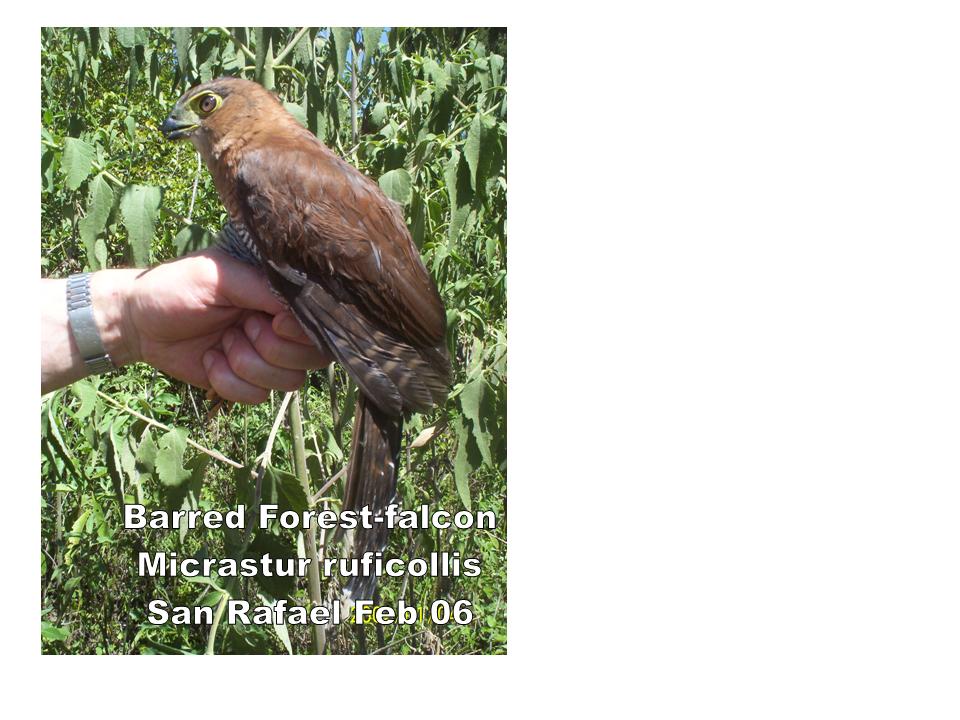
AIMS
“Parque Nacional” San Rafael is one of the most well-watched sites in Paraguay and its importance for wildlife is well-documented (Madroño et al 1997). We aimed to perform a thorough species inventory of the Estancia Nueva Gambach property which, in addition to records already in the Guyra Paraguay database, would help to produce a complete species list for the site. In the process a basic bilingual field guide (English/Spanish) to the birds of the site would be produced, to stimulate interest in birds and conservation amongst visitors to the estancia, and highlight the uniqueness of this fascinating location.
STUDY SITE
Work was concentrated at Estancia Nueva Gambach (26o38´13,3”S, 55o39´50,2”W), the 250ha property of Christine and Hans Hostettler and headquarters of PROCOSARA (Pro Cordillera San Rafael). The Estancia lies just outside the southern border of the proposed area but is adjacent to it and its forest is contiguous with that of the reserve. Approximately 100ha of land has been given over to organic agriculture, mainly cultivation of soya and maize, the rest consists of good quality primary Atlantic forest. The densest forest lies along the Sendero Urutaú on the far side of the lake from the accommodation, but good forest with a more open undergrowth is found along the 600m Sendero Surukuá Say´ju (actually belonging to an adjoining property) which lies close to the accommodation and where much fieldwork was concentrated. There is a 7ha lake, Laguna Hostettler located on the property which attracts some waterbirds. An isolated storm during 2004 felled a number of trees, especially in the area around the lake, and a small herd of cattle now graze there. Occasional visits and field observations were made at the Guyra Paraguay owned property Estancia Kanguery, a natural grassland area and IBA that lies within the boundary of the proposed reserve
METHODS
Fieldwork was conducted during 24 days from 17 February until 12 March 2006. The weather was generally fine and sunny, and only occasional mornings or afternoons were lost to heavy rains. We operated 18 mist nets of c156m total length concentrated mainly along the Sendero Surukua Say´ju, with odd nets placed around the west side of Laguna Hostettler. No netting was performed at Estancia Kanguery. Netting was performed for c9hrs each day, with nets closed during periods of rain and at night. To catch larger birds we placed ground traps baited with maize or apepu (sour orange), with some success. Nightbirds were observed and captured with the aid of a powerful spotlight, hand-held torch and a hand net with a wide head diameter. The surrounding humid forest was surveyed by observers walking pre-existing trails. Approximate daily counts were made for every species.
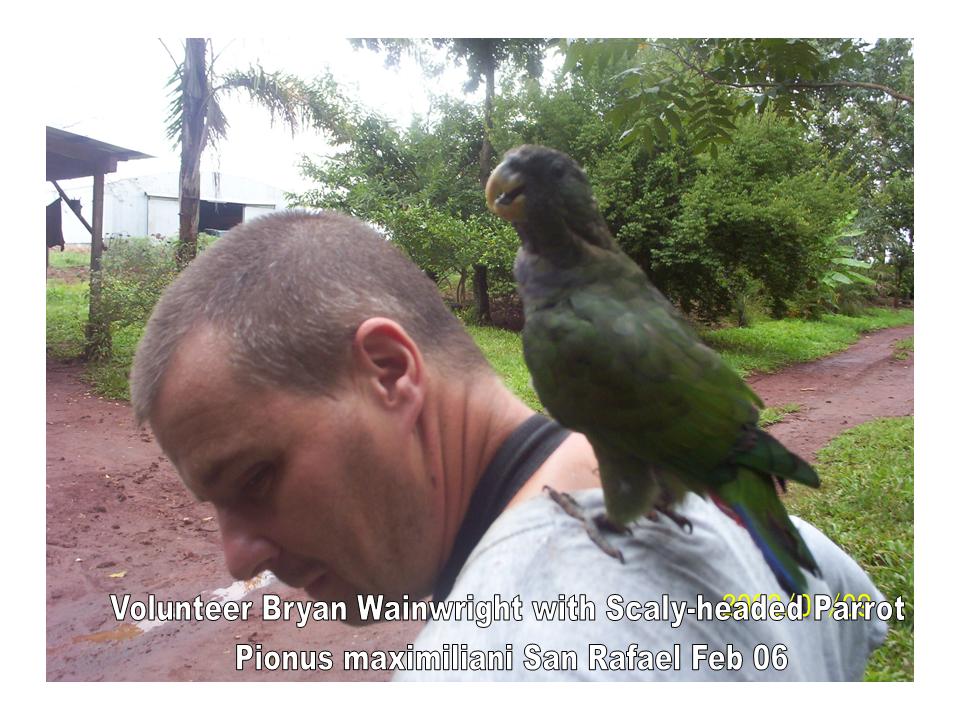
RESULTS
A total of 243 species were recorded during the course of the field work, with 52 species netted. Of the species recorded only one was new for San Rafael - the Scaled Dove Scardafella squamata. After the completion of field work the total species list for San Rafael now stands at 401 (Guyra Paraguay 2006).
The list for Estancia Nueva Gambach is now (311) we having added 11 species to the list for the site. In addition two possible sightings of Sharp-billed Treehunter Heliobletus contaminatus would, if confirmed, also be new. The new species for Estancia Nueva Gambach were: Bare-faced Ibis Phimosus infuscatus, King Vulture Sarcoramphus papa, Scaled Dove Scardafella squamata, Sooty-fronted Spinetail Synallaxis frontalis, Pale-breasted Spinetail Synallaxis albescens, Mottle-cheeked Tyrannulet Phylloscartes ventralis, Crested Becard Pachyramphus validus, Sooty Grassquit Tiaris fuliginosus, Blackish-blue Seedeater Amaurospiza moesta, Great Pampa-finch Embernagra platensis, and Wedge-tailed Grassfinch Emberizoides herbicola.
Below we give brief details of our observations of interest:
Spot-winged Wood-quail Odontophorus capueira - Heard nightly giving loud choruses on going to roost. A maximum of two birds were seen on the same short area of track near the beginning of the Sendero Surukuá Say´ju on subsequent evenings (just before night fell) on the 10th and 11th March. This rarely seen bird appears to be quite common in the area, with at least three separate roost areas with an unknown number of individuals involved being located.
Scaled Dove Scardafella squamata - A single bird observed on the road through the soya on 28 Feb (AB). The observer was familiar with the species from Brazil and noted both the distinctive scaly appearance of the bird and the rufous in the wings as it took flight. It was described as “larger than a Picui Ground-dove but smaller than an Eared Dove”. This species is common in inhabited areas in Brazil and may be expanding its range as deforestation in Paraguay continues.
Saffron Toucanet Baillonius bailloni - Globally near-threatened. A group of five birds consisting of four adults and one juvenile bird were seen on several occasions, often at fruiting trees next to the park guard accommodation. On one occasion an adult was seen to feed the young bird, though it was also seen feeding itself. The juvenile was distinguished by the lack of red on the head, the orbital skin being a pale olive colour and the bill duller and more uniformly green.
Southern Bristle-tyrant Phylloscartes eximius - Globally near-threatened. Found to be fairly common and seen or heard daily, often in the small patch of low trees directly in front of the accommodation. A bird was netted there on 23 Feb.
Cock-tailed Tyrant Alectrurus tricolor - Globally vulnerable. Male birds seen on all visits to Estancia Kanguery, with a maximum of two being recorded on any one visit. The presence of this declining species is partly responsible for the designation of Kanguery as an IBA.
Sharp-tailed Grass-tyrant Culicovora caudate - Globally vulnerable. Several birds seen on all visits to Estancia Kanguery, with a maximum of eight being recorded on any one visit. The presence of this declining species is partly responsible for the designation of Kanguery as an IBA.
Sedge Wren Cistothorus platensis - A widespread species globally, the distribution of this species in Paraguay appears to be restricted to a few areas in the South-central Orient and it is considered nationally near-threatened. Estancia Kanguery is a stronghold for this species and we found the species to be relatively easy to find in wet areas with the use of playback. A maximum of at least five individuals was recorded on any one visit.
Creamy-bellied Gnatcatcher Polioptila lacteal - Globally near-threatened. Found to be not uncommon and a component member of mixed species flocks. A maximum of four individuals were seen in one flock on 25 Feb (PS, BW).
Sooty Grassquit Tiaris fuliginosa - A single female netted on 19 Feb initially created some confusion as to its identity. It was carefully measured and photographed and later identified as this species (though the bill seems to be at the upper extreme of the size range for this species) with the assistance of John Bates and Rob Clay. This is a very little known species in Paraguay, known from only a handful of scattered records in humid forest areas.
Blackish-blue Seedeater Amaurospiza moesta - Globally near-threatened. A rapidly declinging bamboo specialist that is perhaps deserving of a higher conservation category. Two females of this species were seen feeding on the ground low in a bamboo clearing on 25 Feb (AB, BW). The birds were described as being uniformly bright cinnamon-rufous with a large black bill, their small size ruling out confusion with a female grosbeak. A bird was also heard singing in the same area a few days later. Attempts to relocate the species with the aid of playback failed.
Marsh Seedeater Sporophila palustris - Globally endangered. A maximum of three males (and possibly some females) accompanying a mixed seedeater flock seen at Estancia Kanguery on 18 February and 5 March.
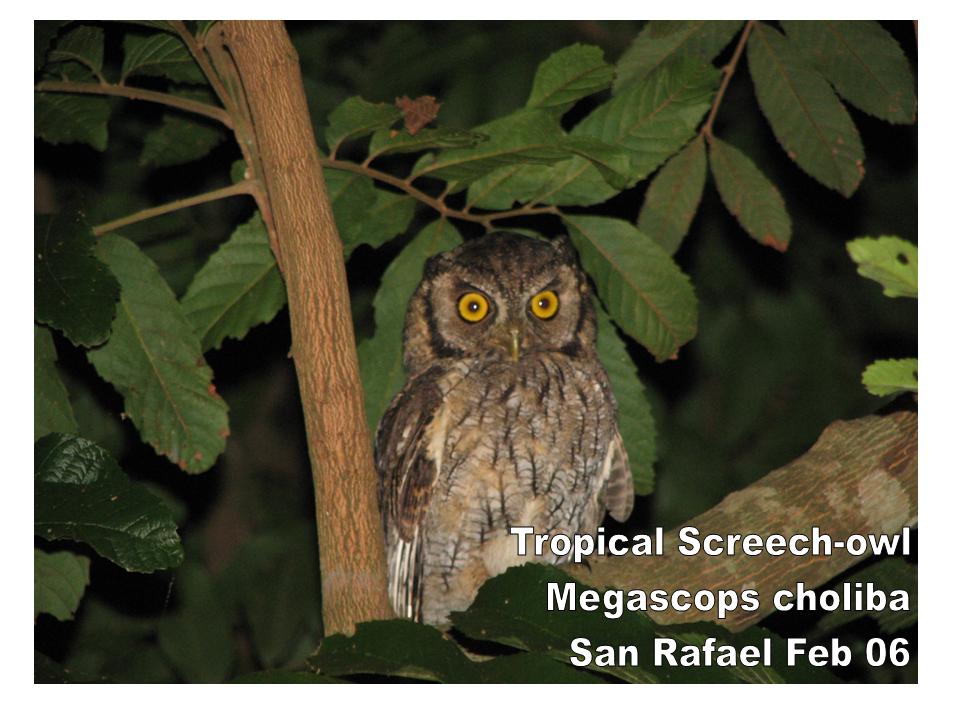
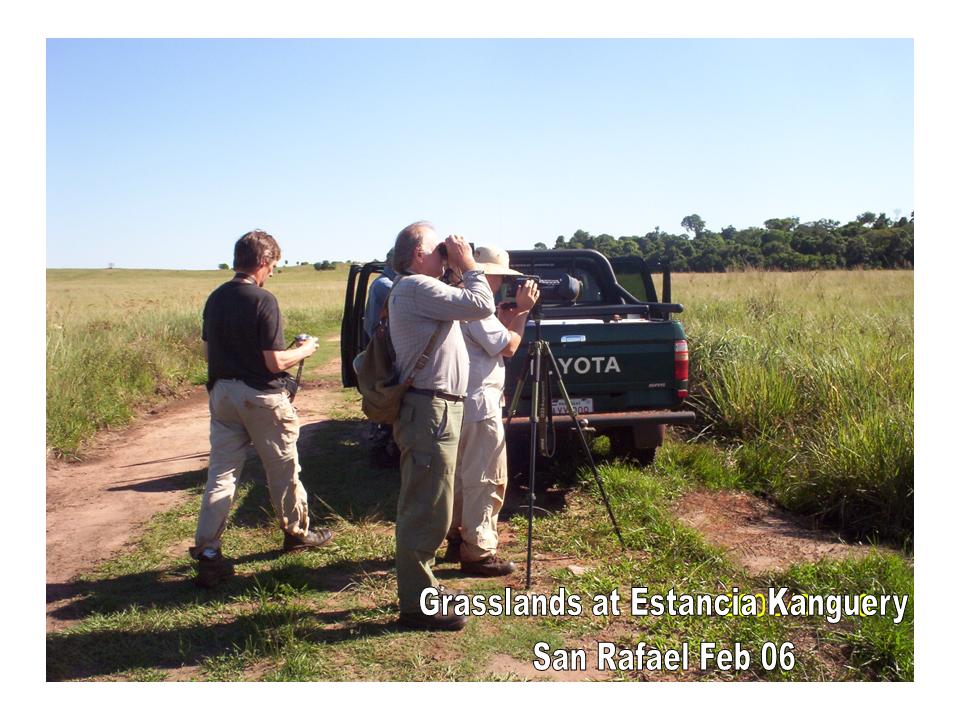
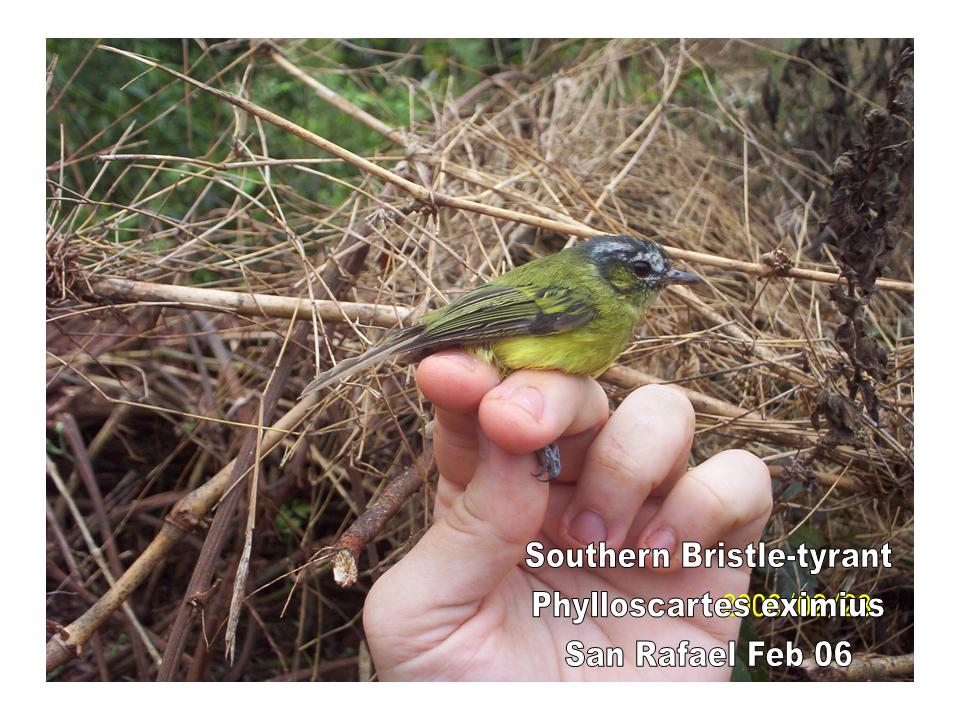
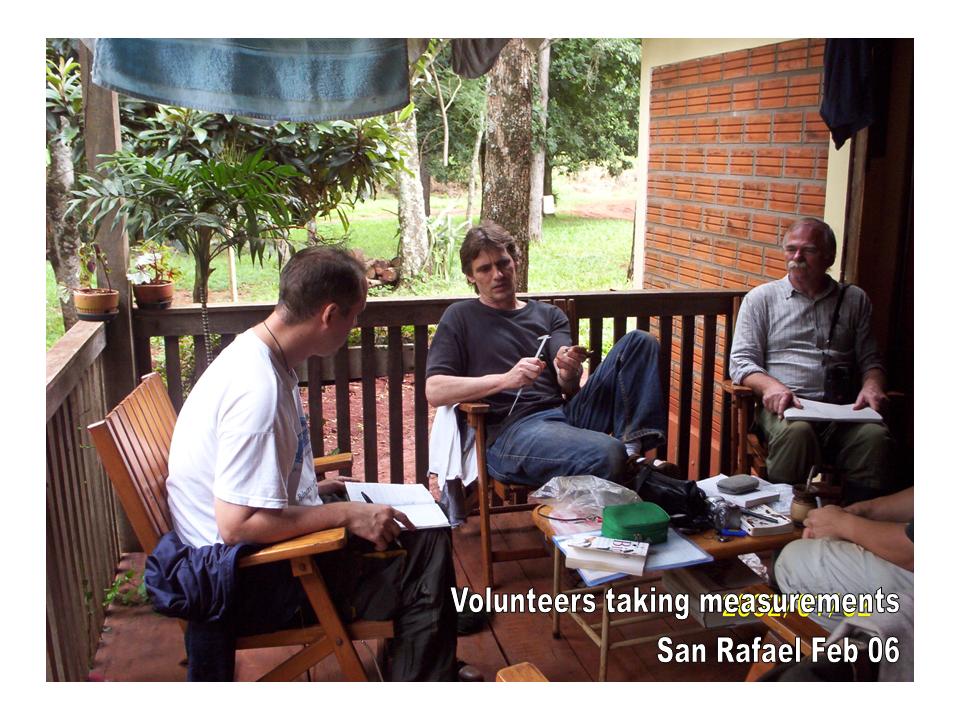
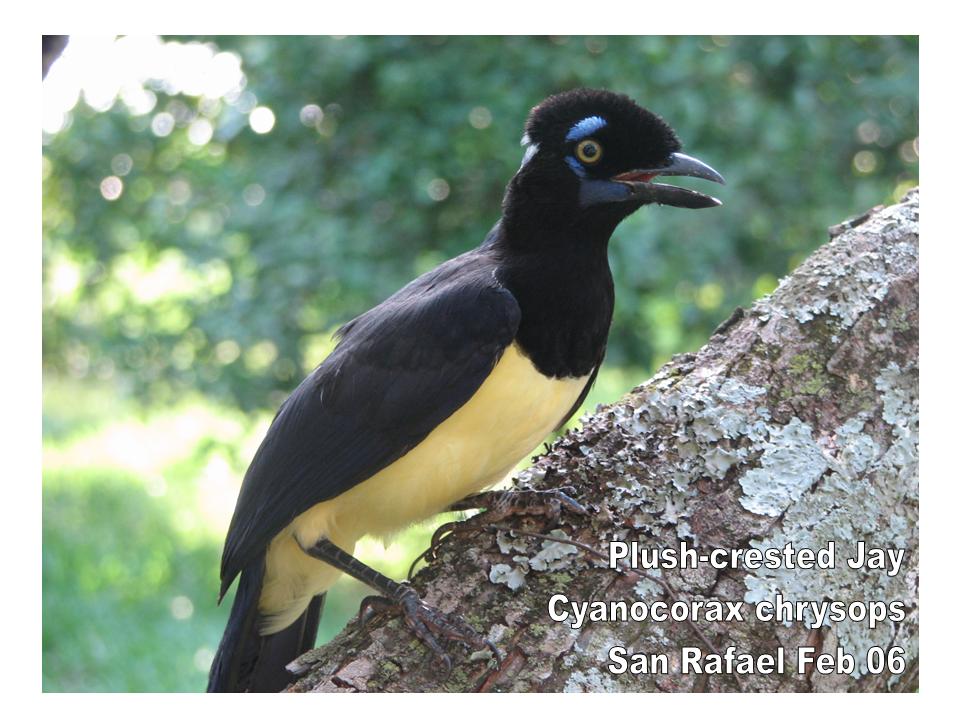
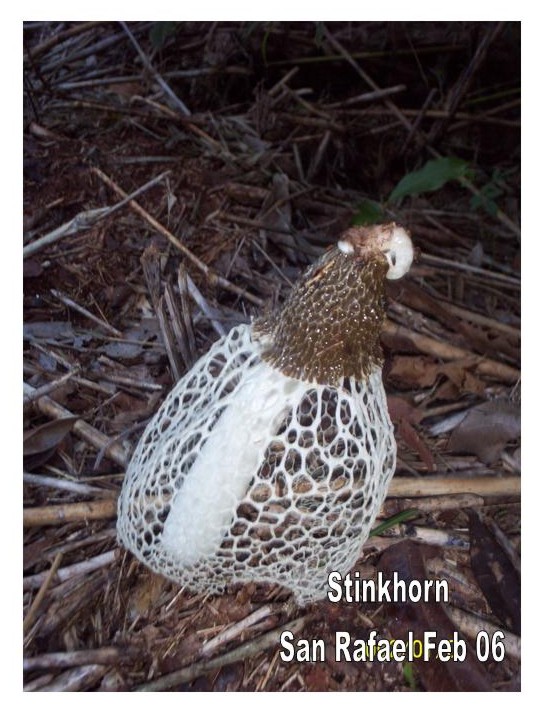
ATLANTIC FOREST ENDEMICS AND THREATENED SPECIES
Eighty-two per cent (64 of 78) of the Atlantic forest endemic species found in Paraguay have been recorded at San Rafael (Madroño et al 1997, Brooks 1999, Guyra Paraguay Database 2006a). Of these we recorded 42 (65.6%) during our field work. Though there are 11 globally-threatened and 14 near-threatened species known from the site, we recorded comparatively few (3 globally threatened and 4 near-threatened) of them (Bird Life International 2004, del Castillo 2006). 142 species recorded here are of national conservation concern - 2CR, 19 EN, 50 VU, 71 NT (see Appendix A), representing 35% of the total species list for the site. We recorded 81 of these species, 57% of the total.
San Rafael is arguably the most important Atlantic Forest site in Paraguay and limited field work has likely under-estimated the number of Atlantic Forest endemics present in the Reserve. It would seem likely that with continued surverying in the area that further Atlantic Forest endemic and globally-threatened species will be added to the site list.
SPECIES COMPOSITION
Along the Sendero Surukuá Say´ju the species composition is typical of primary Atlantic forest in eastern Paraguay. Our mist-netting studies showed that predictably the most common species were Golden-crowned (24 individuals) and White-rimmed Warbler (25) and Black-goggled Tanager (25). Perhaps more surprisingly the large numbers captured of two rarely seen species - Drab-breasted Bamboo-tyrant (4th most abundant species in the nets, 21 indivduals) and Chestnut-headed Tanager (=5th most abundant, 17 individuals) - reveals that they are much more numerous than they may appear. However it should be remembered that netting results are biased towards species living in the undergrowth and greatly under-estimate the abundance of species inhabiting the canopy and mid-levels of the forest strata.
In the canopy one of the most conspicuous and numerous species is the Buff-fronted Foliage-gleaner, this being a regular member of mixed species flocks. Such flocks were on occasion extremely large, containing upwards of 70 individuals birds with a maximum of 36 different species recorded in a single flock. During periods of rain these flocks appeared to move towards the forest edge where they were easily observed, on other occasions they tended to remain within the forest where their component species were harder to catalogue. Core species in these flocks were Creamy-bellied Gnatcatcher, Eastern Sirystes, various becards and White-spotted Woodpecker. Often these canopy flocks were accompanied by a moving train of undergrowth species which typically contained Ochre-collared Piculet, Ochre-breasted and Buff-browed Foliage-gleaners, Chestnut-headed Tanager and Variable Antshrike.
Extensive Chusqea bamboo tangles seemed to attract their own particular avifauna invariably consisting of Dusky-tailed Antbird, Rufous-capped Spinetail, Yellow Tyrannulet, Drab-breasted Bamboo-tyrant and Ochre-faced Tody-flycatcher. Persistent calling by several Plovercrests from a bamboo tangle hidden from view near to the beginning of the Sendero suggested the presence of a lek.
A large number of antbird species were found to be present, and though most were vocal, they generally afforded only brief glimpses. Plain Antvireo and Tufted Antshrike were perhaps the most abundant species, while White-shouldered Fire-eye and Short-tailed Antthrush were surprisingly co-operative towards the end of the Sendero Surkuá Say´ju. Similarly Brown Tinamou, usually extremely hard to observe, was seen with regularity along this trail.
Fruting trees in the garden area attracted the aforementioned mixed species flocks on overcast days, while we were treated to almost daily appearances of Reddish-bellied Parakeet, Grey-fronted Dove, Plush-crested Jay and Saffron Toucanet (including a juvenile bird). Southern Bristle-tyrant and House Wren were usually present, while in the canopy both tityra species, Great Kiskadee and Boat-billed Flycatcher called daily.
The soya area was poor in birds and little time was spent there. Campo Flicker, Guira Cuckoo, Smooth-billed Ani and Whistling Heron fed in grassy areas, while on the runway Rufous Hornero and Burrowing Owl were always present. A large flock of Screaming Cowbird and Chopi Blackbird was usually in the area, generally with a smaller number of Shiny Cowbirds in accompaniment. Spotted Nothura and Small-billed Tinamou were noted with regularity by voice, though rarely seen.
The area around the lake has been heavily affected by the 2004 “mini-tornado” and the toppling of many large trees combined with the grazing of a small herd of cattle has made the area much more open. It has now been colonized by open country species such as Chalk-browed Mockingbird, Ruddy Ground-dove, Sooty-fronted Spinetail, Southern Beardless-tyrannulet and Creamy-bellied Thrush. The lake itself is of limited interest, with the usual array of common waterbirds easy to see eg Wattled Jacana, Solitary Sandpiper, Pied-billed Grebe, Moorhen, Neotropical Cormorant, various heron species and three species of kingfisher. It is surprisingly poor in ducks, with only Brazilian Duck being recorded during our field work. Of more interest was the addition of Bare-faced Ibis to the list, at least two birds being present on most days, while Blackish Rail and Slaty-breasted Wood-rail could generally be seen feeding at the water´s edge near to the forest. Our daily waterbird counts were submitted to Guyra Paraguay for inclusion in the Neotropical Waterbird Census 2006.
A number of additional forest species that appeared to be absent or very rare along the Sendero Surukuá Say´ju were found in the denser forest along the Sendero Urutaú, including Olive Spinetail, Large-tailed Antshrike (heard calling daily but not seen) and Magpie Tanager. In bushier secondary growth near the mouth of the river entering the lake Chicli Spinetail, Social Flycatcher and Long-tailed Tyrant were seen daily, and several pairs of River Warbler were present. A large stand of Chusqea bamboo here brought a sighting of two female Blackish-blue Seedeaters, a rare bamboo specialist.
Nightbirding brought several owl species, including numerous Barn Owls that undoubtedly roost in a large tree close to the hangar. Tropical Screech-owl and Ferruginous Pygmy-owl were also heard nightly. The Rusty-barred Owl that was once easy to see around the accommodation was not recorded and may have moved on following the “mini-hurricane” in 2004. A large reddish-coloured owl that was probably this species was flushed from the forest behind the guard hut at Estancia Kanguery. Pauraque and Common Potoo are easy enough to locate around the football field, while just after dusk Chestnut-banded Nighthawks called as they flew from their forest roosts. The only other caprimulgid was Common Nighthawk, one seen over an open field at Nueva Gambach and at least three more at Estancia Kanguery.
The grassland avifauna of Kanguery revealed many species not seen at Nueva Gambach, including several globally-threatened species - notably Marsh Seedeater, Sharp-tailed Grass Tyrant and Cock-tailed Tyrant. Other grassland birds of interest were Red-winged Tinamou, White-tailed Goldenthroat, Wedge-tailed and Lesser Grassfinch, Capped Seedeater and Sedge Wren, the latter two species rather numerous. A few days prior to our arrival a large flock of Saffron-cowled Blackbirds had been recorded, but despite searching for the species the only Icterids we saw were Yellow-rumped Marshbird and White-browed Blackbird. Small patches of marshy land also housed large numbers of Masked Yellowthroat. We spent one evening staking out Giant Snipe, another speciality species at Kanguery, but failed to see the species.

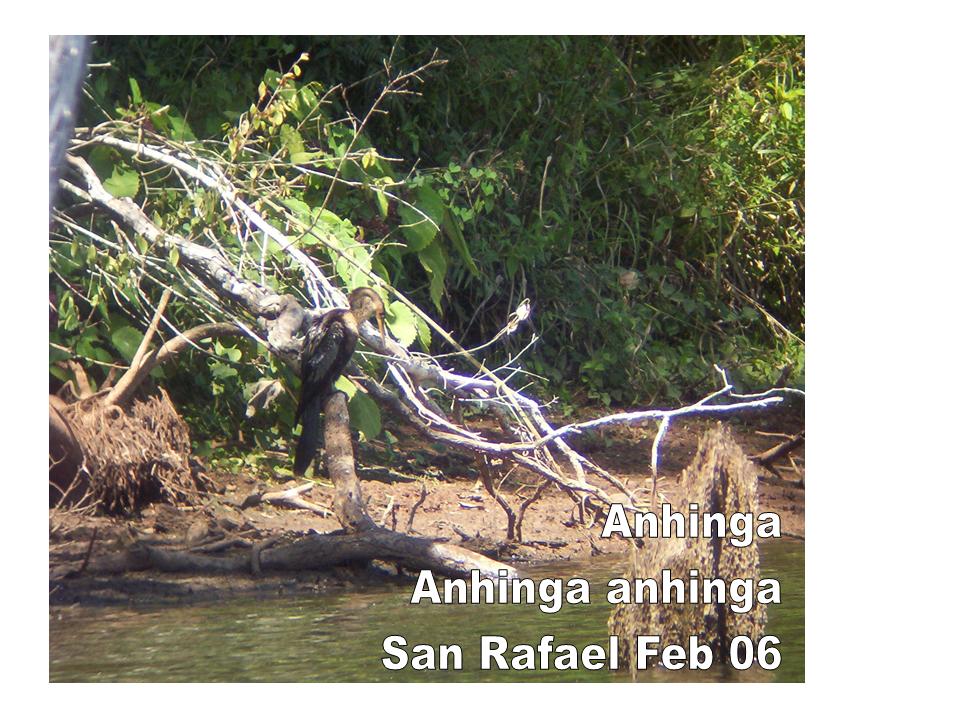
FURTHER OBSERVATIONS OF INTEREST
On 17 February 2006 the distress calls of a female Plovercrest Stephanoxis lalandi fluttering helplessly on the ground drew the attention of Paul Smith. The bird was bound by the right wing and tail by a long strand of caterpillar silk attached to a small sapling c10cm high and of undetermined species, the leaves of which bore the characteristic holes of the recent presence of a feeding caterpillar. In the Atlantic forest of Paraguay several caterpillar species suspend themselves by strands of silk over paths, attaching themselves to passing vertebrates to assist in dispersal. Similar methods are used to move between branches and trees in search of food. The hummingbird did not possess the strength to break the strand alone and appeared tired, but once the silk was removed from its wings and tail manually it was soon able to fly away, apparently unaffected by its ordeal. Though there are several records of hummingbirds becoming snared in spiderwebs this may be the first record of a hummingbird being trapped in caterpillar silk.
A single nest of Eared Dove Zenaida auriculata was found with two pure white eggs (mean 28 x 22.5mm). It was a flattened, shallow (cup 10mm deep) unlined plate (12.5 x 95mm) of roots, lianas and grasses (maximum 2mm in diameter) located on the side of a dead tree at c1m height in the middle of the lake. The nest was exposed and visible from above but hidden from the shore and from the side by dead reedy growth from the side of the tree. It closely matches the description given in de la Peña (1987)
The majority of the bird species captured were in moult, some more heavily than others eg Synallaxis spinetails. Some of the common resident species showed no signs of moulting eg the Basileuterus warblers and Drab-breasted Bamboo-tyrant. Moult details are available on request.
The following mammal species were recorded during fieldwork: Brown Capuchin Cebus capella (sight record); Neotropical Clawed Otter Lontra longicaudis (sight record); Crab-eating Fox Cerdocyon thous (sight records); Little Spotted Cat Oncifelis tigrinus (sight record); Hog-nosed Skunk Conepatus chinga (sight record); Tayra Eira barbara (sight record); Cavy Cavia aperea (sight record at Kanguery); Capybara Hyrdochoeris hydrochaeris (several sight records, dung and prints); an unidentified species of hopping mouse and an unidentified species of grey bat trapped in a nocturnal mist net (Redford & Eisenberg 1992, Emmons & Feer 1999, Guyra Paraguay Database 2006b).
The following reptile species were recorded during fieldwork: Black Tegu Tupinambis merianae (an adult and a juvenile inadvertetently captured); Banded Skink Mabuya frenata (common around accommodation) Tropical Rattlesnake Crotalus durissus (one sight record of large adult); a Parrot Snake Leptophis ahaetulla. and an unidentified species of ground snake Liophis sp? that may have been referable to a variation of poecilogyrus. (P. Cacialli pers. comm.)
THREATS
The numerous threats to San Rafael have been well-documented and are similar to those facing other Atlantic forest areas in Paraguay (Galindo-Leal 2003, Madroño 1997 etc). Illegal logging and total disregard for environmental laws are the main problems, compounded by the government dragging its feet over the legal status of the park. Officially a national park will be declared once the government owns land within the park, but it is unclear how the transfer of ownership from private landowners will take place, especially as a chronic shortage of government finance means that landowners are unlikely to be fully compensated. There is opposition to the park amongst some landowners and the proposed boundaries have been revised many times. In the meantime the only group patrolling the park and reporting illegal activites are the park guards of PROCOSARA. PROCOSARA have a light aircraft but only limited access to 4WD vehicles and their manpower is severely stretched. They have also met with police reluctance to prosecute environmental offenders that they apprehend, the offender being released, usually without charge within a few days.
Population pressure on the outskirts of the reserve is increasing, with poverty rife in the area. This was compounded by President Wasmosy´s decision to settle 78 campesino families within the reserve in October 1997. The land was unsuitable for agriculture and susceptible to frequent flooding, meaning that the families were forced to turn to the forest for sustencance. Hunting has been a problem in the past and few large mammals remain within the reserve. Populations of large gamebirds such as Cracids are also reduced, the population of the globally-threatened Black-fronted Piping-guan now likely extripated. Similarly the Blue-fronted Amazon is also likely extinct within the park, a victim of capture for the pet trade.
San Rafael is experiencing an annual decline in rainfall and an increase in fires (both natural and those started deliberately). The average rainfall has declined from 2173mm annually between 1981-2000 to a maximum of 1891 in the last three years - 2003-2005 (Hans Hostettler data). The decline in rainfall has led to an accompanied drying of the humid forest which makes it more susceptible to fire.
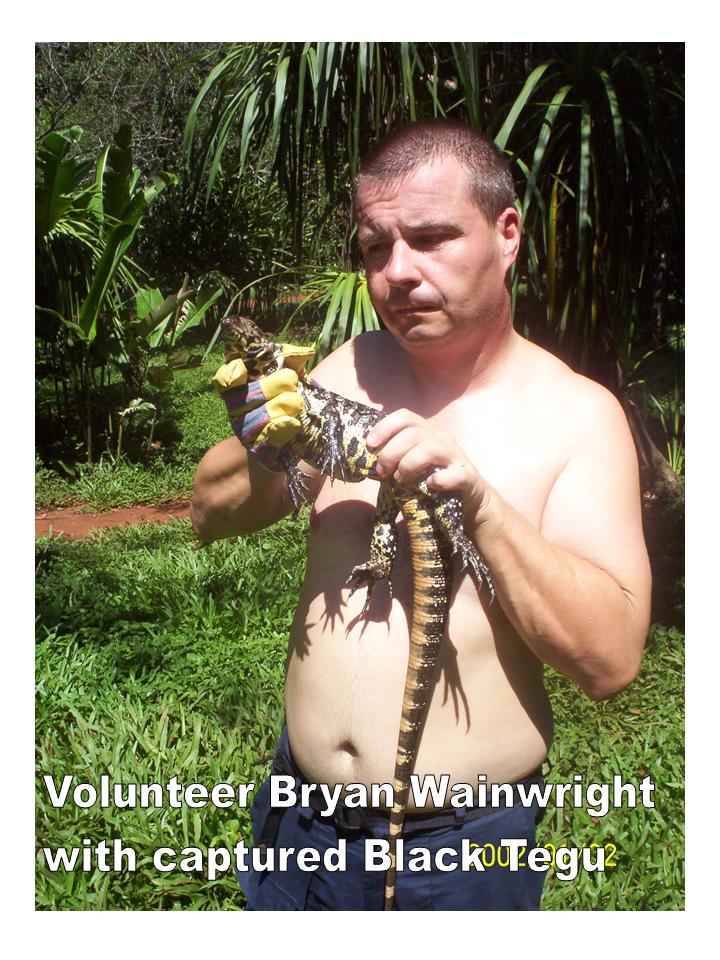
CONCLUDING REMARKS
With ecotourism still in its infancy in Paraguay travel for independent birders can be difficult. This has led to Paraguay becoming something of a “forgotten corner” of South America, despite having a species list that compares more than favourably with similar-sized areas of neighbouring countries. With international attention diverted elsewhere, the plight of the Paraguayan Atlantic Forest and its other endangered habitat types has gone somewhat unnoticed by both the local population and the international birding community.
The sustainable development of tourism is something which Paraguay is just waking up to, though private landowners in general still do not see it as a means of generating income that would compete with farming or ranching. That said Estancia Nueva Gambach’s rustic accommodation and attractive surroundings would seem ideally suited to tourism. The well-maintained forest tracks and lake should appeal to tourists in this landlocked country, while the impressive naturaleza and large number of globally threatened and near threatened bird species should qualify the site as one of the most important in South America. The main problems are those of access (a 4WD vehicle is needed to negotiate the dirt tracks leading to the estancia) and publicity (few people are aware that accommodation is available here!). Owner Christine Hostettler is interested in developing eco-tourism and Bryan Wainwright has put her in contact with a like-minded group at Iracambi, Minais Gerais, Brazil, with the aim to develop sustainable eco-tourism and stimulate research at both sites.
Through the production of the San Rafael mini guide, and subsequent titles in the “Where to Watch Birds in Paraguay” series we hope to raise interest and awareness amongst locals, landowners, birders and biologists in the rich but imminently threatened “naturaleza” of Paraguay and to assist in some small way the conservation of important, but hitherto unprotected sites with eco-touristic potential.
REFERENCES
BirdLife International 2004 - Threatened Birds of the World 2004 CD-Rom.
Brooks TM, Tobias J, Balmford A 1999 - Deforestation and Bird Extinctions in the Atlantic Forest - Animal Conservation 2: p211-222.
Clay RP, del Castillo H 2004 - Annotated Checklist of the Birds of Paraguay - Guyra Paraguay.
De la Peña 1987 - Nidos y Huevos de Aves Argentinas - Published by Author.
Del Castillo H 2006 - Atlas de las Aves del Paraguay - Guyra Paraguay.
Emmons LH, Feer F 1999 - Mamíferos de los Bosques Húmedos de América Tropical - FAN Editorial
Galindo-Leal C, Camara IG 2003 - The Atlantic Forest of South America: Biodiversity Status, Threats and Outlook - Island Press.
Guyra Paraguay Database 2006a - Una Lista de las Aves de San Rafael
Guyra Paraguay Database 2006b - Una Lista de las Mamíferos del Paraguay
Guyra Paraguay Database 2006c - Una Lista de las Reptiles del Paraguay
Hayes FE 1995 - Status, Distribution and Biogeography of the Birds of Paraguay - American Birding Association.
Madroño A, Clay RP, Robbins MB, Rice NH, Faucett RC, Lowen JC 1997 - An Avifaunal Survey of the Vanishing Interior Atlantic Forest of San Rafael National Park, Departments Itapúa/Caazapá, Paraguay - Cotinga 7: p45-53.
Redford KH, Eisenberg JF 1992 - Mammals of the Neotropics Volume 2 The Southern Cone: Chile, Argentina, Uruguay and Paraguay - University of Chicago Press.
Smith P, Clay RP in press - A Field Guide to the Birds of Paraguay
APPENDIX A: SPECIES LIST FOR SAN RAFAEL “NATIONAL PARK”
Column Key 1 = Species Recorded During Project; 2 = Species Trapped During Project; 3 = Endemic Species; 4 Migrant Species; 5 = Global Conservation Status; 6 = National Conservation Status.
Symbol Key: R = Recorded During Project; V = Recorded By Voice During Project; K = Recorded only in or on Route to Kanguery During Project; T = Trapped; AF = Atlantic Forest Endemic; MES = Mesopotamian Grassland Endemic; M = Migrant Species;
1. Rhea americana - Greater Rhea
2. Tinamus solitarius - Solitary Tinamou - AF
3. Crypturellus obsoletus - Brown Tinamou - R T
4. Crypturellus undulatus - Undulated Tinamou
5. Crypturellus parvirostris - Small-billed Tinamou - V
6. Crypturellus tataupa - Tataupa Tinamou - V
7. Rhynchotus rufescens - Red-winged Tinamou - K
8. Nothura maculosa - Spotted Tinamou - R
9. Tachybaptus dominicus - Least Grebe
10. Podilymbus podiceps - Pied-billed Grebe - R
11. Rollandia rolland - White-tufted Grebe
12. Phalacrocorax brasilianus - Neotropical Cormorant - R
13. Anhinga anhinga - Anhinga - R
14. Tigrisoma lineatum - Rufescent Tiger-heron - R
15. Syrigma sibilatrix - Whistling Heron - R
16. Ardea cocoi - Cocoi Heron
17. Ardea alba - Great Egret - R
18. Egretta thula - Snowy Egret - R
19. Bubulcus ibis - Cattle Egret - R
20. Butorides striata - Striated Heron - R M
21. Nycticorax nycticorax - Black-crowned Night-heron - R
22. Cochlearius cochlearius - Boat-billed Heron
23. Phimosus infuscatus - Bare-faced Ibis - R
24. Plegadis chihi - White-faced Ibis
25. Mesembrinibis cayennensis - Green Ibis
26. Platalea ajaja - Roseate Spoonbill
27. Ciconia maguari - Maguari Stork
28. Jabiru mycteria - Jabiru
29. Chauna torquata - Southern Screamer
30. Dendrocygna viduata - White-faced Whistling-duck
31. Coscoroba coscoroba - Coscoroba
32. Netta peposaca - Rosybill
33. Amazonetta brasiliensis - Brazilian Duck - R
34. Cairina moschata - Muscovy Duck
35. Nomonyx dominicus - Masked Duck
36. Coragyps atratus - Black Vulture - R
37. Cathartes aura - Turkey Vulture - R
38. Cathartes burrovianus - Lesser Yellow-headed Vulture - K
39. Sarcoramphus papa - King Vulture - R
40. Leptodon cayanensis - Gray-headed Kite - NT
41. Elanoides forficatus - Swallow-tailed Kite - R M
42. Elanus leucurus - White-tailed Kite - K
43. Rostrhamus sociabilis - Snail Kite - R
44. Harpagus diodon - Rufous-thighed Kite - R M
45. Ictinia plumbea - Plumbeous Kite - R
46. Circus cinereus - Cinereous Harrier
47. Circus buffoni - Long-winged Harrier - R
48. Accipiter erythronemius - Rufous-thighed Hawk - R
49. Accipiter bicolor - Bicolored Hawk - R
50. Geranospiza caerulescens - Crane Hawk
51. Buteogallus urubitinga - Great Black-hawk
52. Buteogallus meridionalis - Savanna Hawk - K
53. Buteo magnirostris - Roadside Hawk - R T
54. Buteo brachyurus - Short-tailed Hawk
55. Buteo albicaudatus - White-tailed Hawk
56. Morphnus guianensis - Crested Eagle
57. Spizastur melanoleucus - Black-and-white Hawk-eagle
58. Spizaetus ornatus - Ornate Hawk-eagle
59. Spizaetus tyrannus - Black Hawk-eagle
60. Caracara plancus - Southern Crested-caracara - K
61. Milvago chimachima - Yellow-headed Caracara - K
62. Milvago chimango - Chimango Caracara - R
63. Herpetotheres cachinnans - Laughing Falcon
64. Micrastur ruficollis - Barred Forest-falcon - R T
65. Micrastur semitorquatus - Collared Forest-falcon- V
66. Falco sparverius - American Kestrel - R
67. Falco femoralis - Aplomado Falcon
68. Falco rufigularis - Bat Falcon
69. Falco peregrinus - Peregrine Falcon
70. Penelope superciliaris - Rusty-margined Guan - R
71. Penelope obscura - Dusky-legged Guan
72. Pipile jacutinga - Black-fronted Piping-guan
73. Crax fasciolata - Bare-faced Curassow
74. Odontophorus capueira - Spot-winged Wood-quail - R AF
75. Laterallus melanophaius - Rufous-sided Crake
76. Aramides cajanea - Gray-necked Wood-rail
77. Aramides saracura - Slaty-breasted Wood-rail - R AF
78. Porzana albicollis - Ash-throated Crake
79. Pardirallus nigricans - Blackish Rail - R
80. Pardirallus sanguinolentus - Plumbeous Rail
81. Porphyrio martinica - Purple Gallinule M
82. Gallinula chloropus - Common Moorhen R
83. Heliornis fulica - Sungrebe
84. Aramus guarauna - Limpkin
85. Cariama cristata - Red-legged Seriema
86. Vanellus chilensis - Southern Lapwing - R
87. Pluvialis dominica - American Golden-Plover - M
88. Himantopus melanurus - White-backed Stilt
89. Jacana jacana - Wattled Jacana - R
90. Tringa solitaria - Solitary Sandpiper - R M
91. Bartramia longicauda - Upland Sandpiper - M
92. Gallinago paraguaiae - South American Snipe - R
93. Gallinago undulata - Giant Snipe
94. Rynchops niger - Black Skimmer
95. Columba livia - Rock Pigeon - R
96. Patagioenas picazuro - Picazuro Pigeon - R
97. Patagioenas cayennensis - Pale-vented Pigeon - R
98. Zenaida auriculata - Eared Dove - R
99. Columbina minuta - Plain-breasted Ground-dove
100. Columbina talpacoti - Ruddy Ground-dove - R
101. Columbina picui - Picui Ground-dove - K
102. Scardafella squamata - Scaled Dove - R
103. Claravis pretiosa - Blue Ground-dove - R
104. Leptotila verreauxi - White-tipped Dove - R
105. Leptotila rufaxilla - Gray-fronted Dove - R T
106. Geotrygon montana - Ruddy Quail-dove
107. Geotrygon violacea - Violaceous Quail-dove
108. Aratinga leucophthalmus - White-eyed Parakeet - R
109. Pyrrhura frontalis - Reddish-bellied Parakeet - R
110. Myiopsitta monachus - Monk Parakeet
111. Forpus xanthopterygius - Blue-winged Parrotlet
112. Brotogeris chiriri - Yellow-chevroned Parakeet
113. Pionopsitta pileata - Pileated Parrot - R
114. Pionus maximiliani - Scaly-headed Parrot - R
115. Amazona vinacea - Vinaceous-breasted Amazon
116. Coccyzus melacoryphus - Dark-billed Cuckoo - R
117. Coccyzus euleri - Pearly-breasted Cuckoo
118. Piaya cayana - Squirrel Cuckoo - R
119. Tapera naevia - Striped Cuckoo
120. Dromococcyx phasianellus - Pheasant Cuckoo
121. Dromococcyx pavoninus - Pavonine Cuckoo
122. Crotophaga major - Greater Ani - M
123. Crotophaga ani - Smooth-billed Ani - R
124. Guira guira - Guira Cuckoo - R
125. Tyto alba - Barn Owl - R
126. Megascops choliba - Tropical Screech-owl - R
127. Megascops atricapilla - Black-capped Screech-owl - AF
128. Pulsatrix koeniswaldiana - Tawny-browed Owl - AF
129. Strix virgata - Mottled Owl
130. Strix huhula - Black-banded Owl
131. Strix hylophila - Rusty-barred Owl - K?
132. Glaucidium brasilianum - Ferruginous Pygmy-owl - R
133. Athene cunicularia - Burrowing Owl - R T
134. Asio flammeus - Short-eared Owl
135. Lurocalis nattereri - Chestnut-banded Nighthawk - R
136. Chordeiles minor - Common Nighthawk - R M
137. Podager nacunda - Nacunda Nighthawk
138. Nyctidromus albicollis - Common Pauraque R T
139. Nyctiphrynus ocellatus - Ocellated Poorwill
140. Caprimulgus rufus - Rufous Nightjar
141. Caprimulgus sericocaudatus - Silky-tailed Nightjar
142. Caprimulgus parvulus - Little Nightjar
143. Hydropsalis torquata - Scissor-tailed Nightjar
144. Eleothreptus anomalus - Sickle-winged Nightjar
145. Nyctibius aethereus - Long-tailed Potoo
146. Nyctibius griseus - Common Potoo - R
147. Chaetura meridionalis - Sick's Swift - R M
148. Chaetura cinereiventris - Gray-rumped Swift - R
149. Phaethornis eurynome - Scale-throated Hermit - R AF
150. Phaethornis pretrei - Planalto Hermit
151. Anthracothorax nigricollis - Black-throated Mango - R
152. Stephanoxis lalandi - Black-breasted Plovercrest - R
153. Chlorostilbon aureoventris - Glittering-bellied Emerald - R
154. Thalurania glaucopis - Violet-capped Woodnymph - AF
155. Hylocharis chrysura - Gilded Sapphire - R
156. Leucochloris albicollis - White-throated Hummingbird - AF
157. Polytmus guainumbi - White-tailed Goldenthroat - K
158. Agyrtria versicolor - Versicolored Emerald
159. Calliphlox amethystina - Amethyst Woodstar
160. Trogon rufus - Black-throated Trogon - R T
161. Trogon surrucura - Surucua Trogon - R AF
162. Baryphthengus ruficapillus - Rufous-capped Motmot - R AF
163. Ceryle torquatus - Ringed Kingfisher - R
164. Chloroceryle amazona - Amazon Kingfisher - R
165. Chloroceryle americana - Green Kingfisher - R
166. Chloroceryle inda - Green-and-rufous Kingfisher
167. Chloroceryle aenea - American Pygmy Kingfisher
168. Notharchus swainsoni - Buff-bellied Puffbird - AF
169. Nystalus chacuru - White-eared Puffbird - R
170. Nonnula rubecula - Rusty-breasted Nunlet
171. Pteroglossus castanotis - Chestnut-eared Aracari - R
172. Selenidera maculirostris - Spot-billed Toucanet - R AF
173. Baillonius bailloni - Saffron Toucanet - R AF
174. Ramphastos dicolorus - Red-breasted Toucan - R
175. Ramphastos toco - Toco Toucan - R
176. Picumnus temmincki - iOchre-collared Piculet - R T AF
177. Picumnus cirratus - White-barred Piculet
178. Melanerpes candidus - White Woodpecker - R
179. Melanerpes flavifrons - Yellow-fronted Woodpecker - R AF
180. Veniliornis spilogaster - White-spotted Woodpecker - R AF
181. Piculus aurulentus - Yellow-browed Woodpecker - AF
182. Colaptes melanochloros - Green-barred Woodpecker - R
183. Colaptes campestris - Campo Flicker - R
184. Celeus flavescens - Blond-crested Woodpecker - R
185. Dryocopus galeatus - Helmeted Woodpecker - AF
186. Dryocopus lineatus - Lineated Woodpecker - R
187. Campephilus robustus - Robust Woodpecker - R AF
188. Dendrocincla turdina - Thrush-like Woodcreeper - R AF
189. Sittasomus griseicapillus - Olivaceous Woodcreeper - R T
190. Xiphocolaptes albicollis - White-throated Woodcreeper - V
191. Dendrocolaptes platyrostris - Planalto Woodcreeper - R T
192. Lepidocolaptes angustirostris - Narrow-billed Woodcreeper
193. Lepidocolaptes falcinellus - Southern Scaled Woodcreeper - R AF
194. Xiphorhynchus fuscus - Lesser Woodcreeper - R T AF
195. Campylorhamphus falcularius - Black-billed Scythebill - AF
196. Furnarius rufus - Rufous Hornero - R
197. Synallaxis ruficapilla - Rufous-capped Spinetail - R T AF
198. Synallaxis frontalis - Sooty-fronted Spinetail - V
199. Synallaxis spixi - Chicli Spinetail - R T
200. Synallaxis albescens - Pale-breasted Spinetail - R
201. Synallaxis cinerascens - Gray-bellied Spinetail - R T
202. Certhiaxis cinnamomeus - Yellow-chinned Spinetail - R
203. Cranioleuca obsoleta - Olive Spinetail - R AF
204. Syndactyla rufosuperciliata - Buff-browed Foliage-gleaner - R T
205. Anabacerthia amaurotis - White-browed Foliage-gleaner - AF
206. Philydor atricapillus - Black-capped Foliage-gleaner - R AF
207. Philydor lichtensteini - Ochre-breasted Foliage-gleaner - R T AF
208. Philydor rufum - Buff-fronted Foliage-gleaner - R
209. Automolus leucophthalmus - White-eyed Foliage-gleaner - R T AF
210. Heliobletus contaminatus - Sharp-billed Treehunter - R? AF
211. Xenops rutilans - Streaked Xenops - R
212. Xenops minutus - Plain Xenops - R T
213. Sclerurus scansor - Rufous-breasted Leaftosser - K? AF
214. Lochmias nematura - Sharp-tailed Streamcreeper
215. Hypoedaleus guttatus - Spot-backed Antshrike - R AF
216. Mackenziaena leachii - Large-tailed Antshrike - V AF
217. Mackenziaena severa - Tufted Antshrike - R T AF
218. Thamnophilus doliatus - Barred Antshrike
219. Thamnophilus caerulescens - Variable Antshrike - R T
220. Dysithamnus mentalis - Plain Antvireo - R T
221. Herpsilochmus atricapillus - Black-capped Antwren
222. Herpsilochmus rufimarginatus - Rufous-winged Antwren - R
223. Drymophila rubricollis - Bertoni’s Antbird - AF
224. Drymophila malura - Dusky-tailed Antbird - R T AF
225. Terenura maculata - Streak-capped Antwren - R AF
226. Pyriglena leucoptera - White-shouldered Fire-eye - R T AF
227. Chamaeza campanisona - Short-tailed Antthrush - R
228. Grallaria varia - Variegated Antpitta - V
229. Hylopezus nattereri - Speckle-breasted Antpitta - AF
230. Conopophaga lineata - Rufous Gnateater - R T AF
231. Phyllomyias burmeisteri - Rough-legged Tyrannulet
232. Phyllomyias virescens - Greenish Tyrannulet - AF
233. Camptostoma obsoletum - Southern Beardless-tyrannulet - R
234. Phaeomyias murina - Mouse-coloured Tyrannulet - M
235. Capsiempis flaveola - Yellow Tyrannulet - R
236. Suiriri suiriri - Suiriri Flycatcher
237. Myiopagis caniceps - Gray Elaenia - R
238. Myiopagis viridicata - Greenish Elaenia - R M
239. Elaenia flavogaster - Yellow-bellied Elaenia - R
240. Elaenia spectabilis - Large Elaenia - M
241. Elaenia albiceps - White-crested Elaenia - R M
242. Elaenia parvirostris - Small-billed Elaenia - K M
243. Elaenia mesoleuca - Olivaceous Elaenia
244. Serpophaga subcristata - White-crested Tyrannulet - M
245. Culicivora caudacuta - Sharp-tailed Grass-tyrant - K
246. Polystictus pectoralis - Bearded Tachuri
247. Euscarthmus meloryphus - Tawny-crowned Pygmy-tyrant
248. Mionectes rufiventris - Gray-hooded Flycatcher - AF
249. Leptopogon amaurocephalus - Sepia-capped Flycatcher - R T
250. Pogonotriccus eximius - Southern Bristle-tyrant - R T AF
251. Phylloscartes ventralis - Mottle-cheeked Tyrannulet - R
252. Phylloscartes paulista - Sao Paulo Tyrannulet - AF
253. Phylloscartes sylviolus - Bay-ringed Tyrannulet - AF
254. Corythopis delalandi - Southern Antpipit - R
255. Myiornis auricularis - Eared Pygmy-tyrant - R - AF
256. Hemitriccus diops - Drab-breasted Bamboo-tyrant - R T AF
257. Hemitriccus margaritaceiventer - Pearly-vented Tody-tyrant
258. Poecilotriccus plumbeiceps - Ochre-faced Tody-flycatcher - R T
259. Ramphotrigon megacephalum - Large-headed Flatbill
260. Tolmomyias sulphurescens - Yellow-olive Flycatcher - R
261. Platyrinchus mystaceus - White-throated Spadebill - R T
262. Platyrinchus leucoryphus - Russet-winged Spadebill - AF
263. Myiophobus fasciatus - Bran-colored Flycatcher - R M
264. Lathrotriccus euleri - Euler’s Flycatcher - R T M
265. Contopus cinereus - Tropical Pewee
266. Cnemotriccus fuscatus - Fuscous Flycatcher - M
267. Pyrocephalus rubinus - Vermilion Flycatcher - M
268. Xolmis cinereus - Gray Monjita
269. Knipolegus cyanirostris - Blue-billed Black-tyrant - M
270. Hymenops perspicillatus - Spectacled Tyrant - M
271. Colonia colonus - Long-tailed Tyrant - R
272. Alectrurus tricolor - Cock-tailed Tyrant - K
273. Alectrurus risora - Strange-tailed Tyrant
274. Gubernetes yetapa - Streamer-tailed Tyrant - R
275. Satrapa icterophrys - Yellow-browed Tyrant
276. Machetornis rixosa - Cattle Tyrant - R
277. Attila phoenicurus - Rufous-tailed Attila
278. Casiornis rufus - Rufous Casiornis
279. Sirystes sibilator - Eastern Sirystes - R
280. Myiarchus swainsoni - Swainson’s Flycatcher - R M
281. Myiarchus ferox - Short-crested Flycatcher - R
282. Myiarchus tyrannulus - Brown-crested Flycatcher - K
283. Pitangus sulphuratus - Great Kiskadee - R T
284. Megarynchus pitangua - Boat-billed Flycatcher - R
285. Myiozetetes similis - Social Flycatcher - R T
286. Conopias trivirgatus - Three-striped Flycatcher
287. Myiodynastes maculatus - Streaked Flycatcher - R M
288. Legatus leucophaius - Piratic Flycatcher M
289. Empidonomus varius - Variegated Flycatcher - R
290. Tyrannus melancholicus - Tropical Kingbird - R M
291. Tyrannus savana - Fork-tailed Flycatcher - K M
292. Pachyramphus viridis - Green-backed Becard - R
293. Pachyramphus castaneus - Chestnut-crowned Becard - R
294. Pachyramphus polychopterus - White-winged Becard - R T M
295. Pachyramphus validus - Crested Becard - R
296. Tityra cayana - Black-tailed Tityra - R
297. Tityra inquisitor - Black-crowned Tityra - R
298. Schiffornis virescens - Greenish Schiffornis - R T AF
299. Piprites chloris - Wing-barred Piprites - K V
300. Chiroxiphia caudata - Blue Manakin - R T AF
301. Pipra fasciicauda - Band-tailed Manakin - R T
302. Pyroderus scutatus - Red-ruffed Fruitcrow - R AF
303. Procnias nudicollis - Bare-throated Bellbird - AF
304. Oxyruncus cristatus - Sharpbill - R
305. Cyanocorax cyanomelas - Purplish Jay
306. Cyanocorax chrysops - Plush-crested Jay - R T
307. Tachycineta leucorrhoa - White-rumped Swallow - M
308. Tachycineta meyeni - Chilean Swallow - M
309. Progne tapera - Brown-chested Martin - R M
310. Progne chalybea - Gray-breasted Martin - R M
311. Notiochelidon cyanoleuca - Blue-and-white Swallow
312. Alopochelidon fucata - Tawny-headed Swallow
313. Stelgidopteryx ruficollis - Southern Rough-winged Swallow - R M
314. Riparia riparia - Bank Swallow - M
315. Hirundo rustica - Barn Swallow - M
316. Petrochelidon pyrrhonota - Cliff Swallow - R M
317. Campylorhynchus turdinus - Thrush-like Wren - R
318. Cistothorus platensis - Sedge Wren - K
319. Troglodytes aedon - House Wren - R T
320. Polioptila lactea - Creamy-bellied Gnatcatcher - R AF
321. Turdus subalaris - Eastern Slaty-thrush - AF
322. Turdus rufiventris - Rufous-bellied Thrush - R T
323. Turdus leucomelas - Pale-breasted Thrush - R T
324. Turdus amaurochalinus - Creamy-bellied Thrush - R
325. Turdus albicollis - White-necked Thrush - R
326. Mimus saturninus - Chalk-browed Mockingbird - R
327. Anthus lutescens - Yellowish Pipit
328. Anthus nattereri - Ochre-breasted Pipit
329. Vireo olivaceus - Red-eyed Vireo - R
330. Hylophilus poicilotis - Rufous-crowned Greenlet - R AF
331. Cyclarhis gujanensis - Rufous-browed Peppershrike - R
332. Parula pitiayumi - Tropical Parula - R
333. Geothlypis aequinoctialis - Masked Yellowthroat - K
334. Basileuterus culicivorus - Golden-crowned Warbler - R T
335. Basileuterus leucoblepharus - White-rimmed Warbler - R T AF
336. Basileuterus rivularis - Neotropical River Warbler - R T
337. Conirostrum speciosum - Chestnut-vented Conebill - R
338. Pipraeidea melanonota - Fawn-breasted Tanager
339. Tangara seledon - Green-headed Tanager - R AF
340. Tangara cayana - Burnished-buff Tanager
341. Dacnis cayana - Blue Dacnis - R
342. Chlorophonia cyanea - Blue-naped Chlorophonia - R
343. Euphonia chlorotica - Purple-throated Euphonia - R
344. Euphonia violacea - Violaceous Euphonia
345. Euphonia pectoralis - Chestnut-bellied Euphonia - R AF
346. Euphonia chalybea - Green-chinned Euphonia - AF
347. Euphonia cyanocephala - Golden-rumped Euphonia
348. Stephanophorus diadematus - Diademed Tanager
349. Thraupis bonariensis - Blue-and-yellow Tanager M
350. Thraupis sayaca - Sayaca Tanager - R
351. Habia rubica - Red-crowned Ant-Tanager - R T
352. Tachyphonus rufus - White-lined Tanager
353. Tachyphonus coronatus - Ruby-crowned Tanager - R T AF
354. Trichothraupis melanops - Black-goggled Tanager - R T
355. Pyrrhocoma ruficeps - Chestnut-headed Tanager - R T AF
356. Nemosia pileata - Hooded Tanager - R
357. Hemithraupis guira - Guira Tanager - R
358. Thlypopsis sordida - Orange-headed Tanager
359. Cissopis leveriana - Magpie Tanager - R
360. Tersina viridis - Swallow Tanager - R M
361. Saltator coerulescens - Grayish Saltator
362. Saltator similis - Green-winged Saltator - R
363. Saltator fuliginosus - Black-throated Grosbeak - AF
364. Cyanocompsa brissonii - Ultramarine Grosbeak - R T
365. Cyanoloxia glaucocaerulea - Glaucous-blue Grosbeak - M
366. Coryphospingus cucullatus - Red-crested Finch - R
367. Arremon flavirostris - Saffron-billed Sparrow
368. Tiaris fuliginosa - Sooty Grassquit - R T
369. Amaurospiza moesta - Blackish-blue Seedeater - R AF
370. Oryzoborus angolensis - Lesser Seed-finch
371. Sporophila caerulescens - Double-collared Seedeater - R
372. Sporophila bouvreuil - Capped Seedeater - K
373. Sporophila hypoxantha - Tawny-bellied Seedeater - K
374. Sporophila palustris - Marsh Seedeater - K MG M
375. Sporophila cinnamomea - Chestnut Seedeater - MG M
376. Volatinia jacarina - Blue-black Grassquit - R
377. Embernagra platensis - Great Pampa-finch - R
378. Emberizoides herbicola - Wedge-tailed Grass-finch - R
379. Emberizoides ypiranganus - Lesser Grass-finch - K
380. Sicalis flaveola - Saffron Finch - R
381. Sicalis luteola - Grassland Yellow-finch
382. Donacospiza albifrons - Long-tailed Reed-finch
383. Haplospiza unicolor - Uniform Finch - AF
384. Ammodramus humeralis - Grassland Sparrow - K
385. Zonotrichia capensis - Rufous-collared Sparrow - R
386. Molothrus bonariensis - Shiny Cowbird - R
387. Molothrus rufoaxillaris - Screaming Cowbird - R
388. Molothrus oryzivorus - Giant Cowbird
389. Cacicus haemorrhous - Red-rumped Cacique - R
390. Cacicus chrysopterus - Golden-winged Cacique - R T
391. Cacicus solitarius - Solitary Cacique
392. Gnorimopsar chopi - Chopi Blackbird - R
393. Agelasticus cyanopus - Unicolored Blackbird
394. Chrysomus ruficapillus - Chestnut-capped Blackbird
395. Xanthopsar flavus - Saffron-cowled Blackbird
396. Icterus cayanensis - Epaulet Oriole - R
397. Amblyramphus holosericeus - Scarlet-headed Blackbird
398. Pseudoleistes guirahuro - Yellow-rumped Marshbird - K
399. Sturnella superciliaris - White-browed Blackbird - K
400. Carduelis magellanica - Hooded Siskin
401. Passer domesticus - House Sparrow
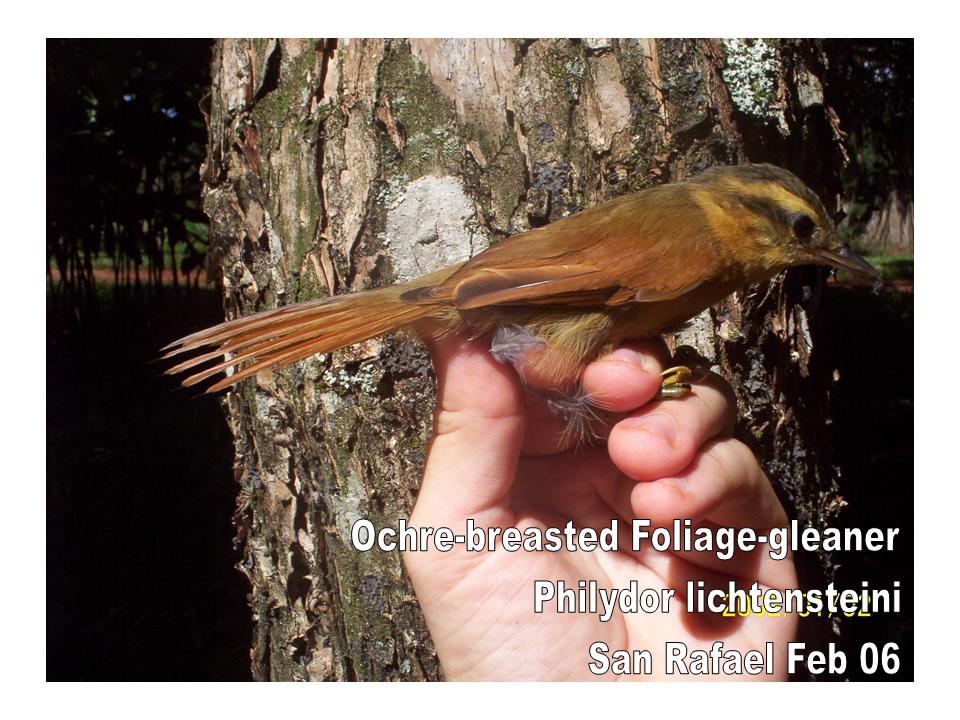
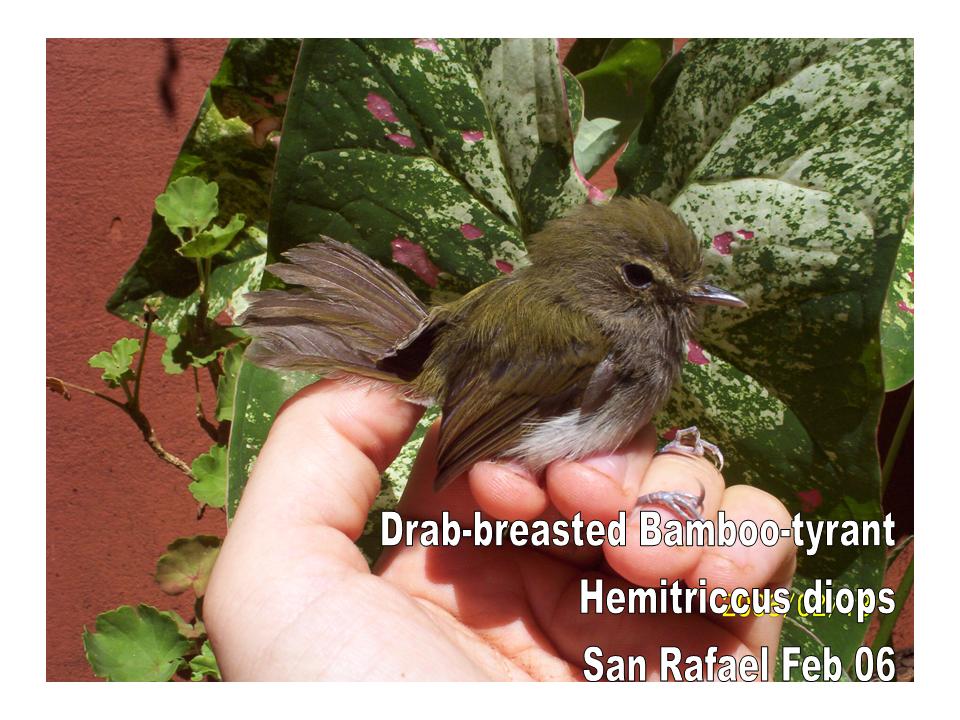
APPENDIX B - MEASUREMENTS
This appendix is available as a separate document on email request from FAUNA Paraguay at faunaparaguay@yahoo.com.ar
ACKNOWLEDGEMENTS
Particular thanks to Christine and Hans Hostettler for allowing us the run of their property and use of their excellent facilities. The PROCOSARA guards deserve special mention for their hardwork and friendship. Santa made sure we were all well fed during our time in the field. Thanks to Guyra Paraguay for their continued support of the mini-guide scheme and Hugo del Castillo for help with logistics. Finally many thanks to the three volunteers on this project - Attila Bankovics, Lars Hansen and Bryan Wainwright - without whom this project would not have been possible.

Designed by Paul Smith 2006. This website is copyrighted by law.
Material contained herewith may not be used without the prior written permission of FAUNA Paraguay.
Photographs on this web-site were taken by Paul Smith, Hemme Batjes, Regis Nossent,
Alberto Esquivel, Arne Lesterhuis, Rebecca Zarza and Hugo del Castillo and are used with their permission.
INTRODUCTION
The Atlantic forest of southern Brazil, eastern Paraguay and northeast Argentina has been declared by Conservation International to be in need of “Critical Conservation Attention”, highlighting the rapid rate of deforestation of this unique habitat (Galindo-Leal 2003). One of the largest remaining tracts of Atlantic Forest in Paraguay is in the San Rafael area of the southern Paraguayan Orient, Departamentos Itapúa and Caaguazú. Declared an “Area Designated for a National Park” in 1992, the legal status of San Rafael has remained unclear ever since. In 2002 its status changed to Managed Recourses Reserve on account of the government having failed to acquire land within the reserve´s boundary. Early in 2006 the title again reverted to “Area Designated for a National Park” but a National Park cannot be declared until land comes under government ownership (IDEA and Christine Hostettler pers comm.). The status of the park has been the subject of legal wrangles, causing strong sentiments and even violence, and its legal protection has still not been secured. As a result of the uncertainty the Allianza para la Conservación de la Reserva San Rafael (Alliance for the Conservation of San Rafael Reserve) was formed in December 2001, with founder members including Guyra Paraguay, PROCOSARA, the National Land Trust and IDEA (Instituto de Deerecho y Economía Ambiental). The intention of the Alliance is to implement alternative means of protection within the reserve, including the active purchase of land (Guyra Paraguay have purchased several tracts of land within the reserve area including amongst others the IBA “Important Bird Area” Estancia Kanguery), the pursual of legal means of assuring its protection (IDEA) and the formation of a group of park guards by PROCOSARA (Christine Hostettler and Alberto Yanosky pers.comm.). The reserve remains one of the highest conservation priorities in Paraguay (Madroño et al 1997).














